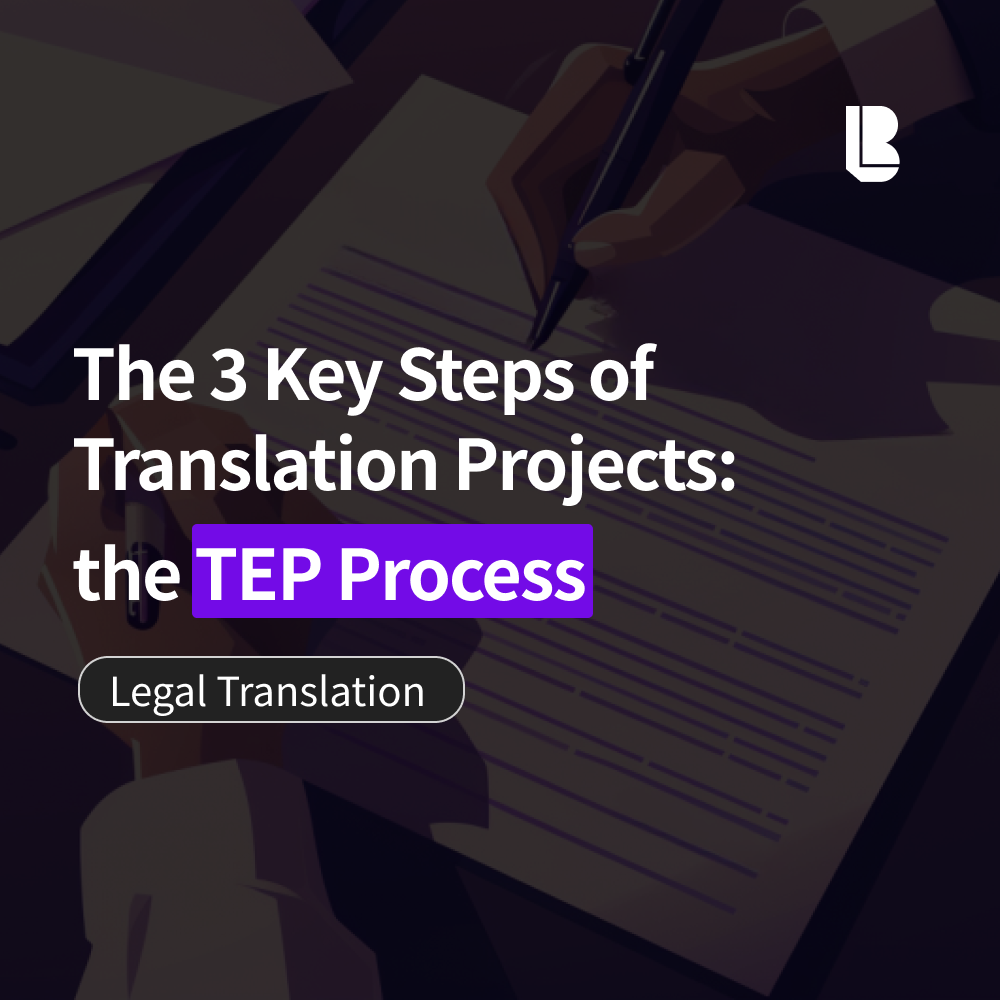Today, let’s explore the core of translation projects—the “TEP Process.” Wondering what TEP stands for? It’s short for “Translation-Editing-Proofreading,” the three essential steps in a translation project. In simple terms, these stages ensure the quality and accuracy of your translation.
Why is the TEP process important? Translation isn’t just about changing words from one language to another. It’s about conveying the original meaning and nuance while making the text clear and natural for readers. Following the TEP process ensures both goals are met. This is especially true in legal translations, where even a small error can lead to significant issues. Accuracy is everything in legal documents.
However, if you’re a professional translator, you may have wondered, “Is it realistic to always follow the TEP process? It takes too long.” You’re right—while it boosts quality, it can also increase time and costs.
That’s where BeringLab’s solution comes in. BeringAI, a top-tier legal translation tool, significantly enhances the efficiency of the TEP process. It speeds up the Translation stage with accurate, fast drafts and simplifies the Editing and Proofreading stages with consistent terminology and contextual understanding. Let’s dive deeper into the TEP process and see how BeringAI makes it more efficient.
✍🏻 What is the Purpose of Translation?

Before starting a translation project, the most important thing is understanding its purpose. Translation isn’t just about switching languages; it’s about delivering the original meaning and tone.
The purpose of translation can be divided into two key goals:
- Accuracy: It’s crucial to convey the information and nuance of the original text accurately. For instance, when translating legal documents, even a small difference in meaning can cause big problems. That’s why accuracy is the top priority.
- Fluency: The translated text should be easy and natural for readers to understand. No matter how accurate the translation is, if it’s difficult to read, it’s not a good translation. This is especially important in creative works or marketing materials.
The ultimate goal of translation is to achieve both accuracy and fluency. When both are accomplished, we can say the translation is successful.
✍🏻 Breaking Down the TEP Process

To achieve these goals, a precise translation process called TEP is necessary. TEP stands for Translation, Editing, and Proofreading—essential steps for high-quality translation. By going through these three stages, both accuracy and fluency can be ensured.
- Translation: This is the foundational step where the original text is translated into the target language. It’s more than just replacing words; understanding the context and nuance is crucial, especially in fields like legal translation where correct terminology and sentence structure are vital.
- Editing: In this stage, the translated text is refined and improved. The editor compares it with the original text to ensure no content was missed and that the meaning is accurately conveyed. This step also checks the grammar and naturalness of the target language.
- Proofreading: The final stage involves catching small errors like spelling, grammar, or punctuation mistakes. Even a tiny error can change the overall meaning, so this step is essential for finalizing the translation.
While these steps ensure quality, they also require specialized skills and take time and resources. Consistent terminology and maintaining style are crucial across all stages.
✍🏻 How AI Simplifies the TEP Process
Going through all three steps results in high-quality translations, but as you can imagine, it takes time and effort. This is where BeringAI comes in to revolutionize the process.
BeringAI can make the TEP process much more efficient. During the Translation phase, it selects the correct terms and accurately understands complex sentence structures, providing a strong draft translation. In the Editing stage, you can then focus on comparing the translation with the original, making refinements where needed.
BeringAI’s glossary feature ensures consistent translations of specific terms across the entire document. For instance, in legal translations, frequently used terms can be pre-loaded into the glossary, ensuring that BeringAI consistently uses the correct translations throughout the document.
If needed, BeringLab’s legal experts can also review the translations. By utilizing BeringAI, you can enhance both the quality and efficiency of the TEP process.

Now that we’ve discussed the two main goals of translation—accuracy and fluency—how does BeringAI achieve these?
- Accuracy: BeringAI excels in this area, especially in specialized fields like legal documents. It’s trained on vast legal data, so it can handle complex terminology and sentence structures, preserving the original intent and nuance without compromising legal meaning.
- Fluency: BeringAI creates natural-sounding sentences in the target language. It maintains the formal tone required for legal and business documents while ensuring that the overall text is easy to read and understand.
Whether you’re translating one long document or multiple related texts, BeringAI consistently delivers the same high level of accuracy and fluency throughout.
BeringAI offers the perfect solution for modern business translation needs, making legal translation faster and more efficient. Why not experience it for yourself? Visit BeringLab’s website to sign up and start your free trial today!

